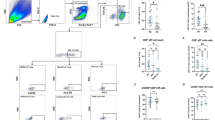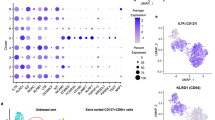Abstract
We investigated myeloid-dendritic cell (DC) marker and Toll-like receptor (TLR)-2 and 4 distributions in ileal samples from Crohn's disease (CD) patients (n = 14) and controls (n = 13). In controls, no TLR-2+ cells were observed, and higher numbers of TLR-4+ and DC-SIGN+ cells (P < 0.01) were detected in ileal samples when compared versus colonic tissues. In non-inflamed CD ileum, TLR-4+ and DC-SGN+ cells were depleted from superficial areas of the villus, and a significant CD1a+ cell infiltration (P < 0.01) was observed when compared to ileal controls and non-inflamed colonic CD samples. In inflamed CD ileum, DC-SIGN+, CD1a+, TLR-4+ and few TLR-4+DC-SIGN+ cells were detected as well as CD83 depletion. No correlation between TLR-2 and DC markers was detected in CD samples. A unique distribution of myeloid-DC markers characterized the CD ileum. Also, the presence of significant amounts of ileal CD1a+ cells may provide a relevant DC-mediated mechanism for antigen recognition in the pathogenesis of CD.






Similar content being viewed by others
References
Bouma G, Strober W (2003) The immunological and genetic basis of inflammatory bowel disease. Nat Rev Immunol 3:521–533
de Baey A, Mende I, Baretton G, Greiner A, Hartl WH, Baeuerle PA, Diepolder HM (2003) A subset of human dendritic cell in the T cell area of mucosa-associated lymphoid tissue with a high potential to produce TNF-α. J Immunol 170:5089–5094
te Velde AA, van Kooyk Y, Braat H, Hommes DW, Dellemijn TA, Slors JF, van Deventer SJ, Vyth-Dreese FA (2003) Increased expression of DC-SIGN+IL-12+IL-18+ and CD83+IL-12-IL-18- dendritic cell populations in the colonic mucosa of patients with Crohn’s disease. Eur J Immunol 33:143–151
Silva MA, López CB, Riverin F, Oligny L, Menezes J, Seidman EG (2004) Characterization and distribution of colonic dendritic cells in Crohn's disease. Inflamm Bowel Dis 10:504–512
Baumgart DC, Metzke D, Schmitz J, Scheffold A, Sturm A, Wiedenmann B, Dignass AU (2005) Patients with active inflammatory bowel disease lack immature peripheral blood plasmacytoid and myeloid dendritic cells. Gut 54:228–236
Hart AL, Al-Hassi HO, Rigby RJ, Bell SJ, Emmanuel AV, Knight SC, Kamm MA, Stagg AJ (2005) Characteristics of intestinal dendritic cells in inflammatory bowel disease. Gastroenterology 129:50–65
Middel P, Raddatz D, Gunawan B, Haller F, Radzun HJ (2006) Increased number of mature dendritic cells in Crohn´s disease: evidence for a chemokine mediated retention mechanism. Gut 55:220–227
Guermonprez P, Valladeau J, Zitvogel L (2002) Antigen presentation and T cell stimulation by dendritic cells. Annu Rev Immunol 20:621–667
Liu L, MacPherson G (1995) Rat intestinal dendritic cells: immunostimulatory potency and phenotypic characterization. Immunology 85:88–93
Takeda K, Kaisho T, Akira S (2003) Toll-like receptors. Ann Rev Immunol 21:335–376
Parker L, Prince L, Sabroe I (2007) Translational mini-review series on Toll-Like receptors: Networks regulated by Toll-like receptors mediate innate and adaptive immunity. Clin Exp Immunol 147:199–207
Franchimont D, Vermeire S, El Housni H, Pierik M, Van Steen K, Gustot T, Quertinmont E, Abramowicz M, Van Gossum A, Devière J, Rutgeerts P (2004) Deficient host-bacteria interactions in inflammatory bowel disease? The toll-like receptor (TLR)-4 Asp299gly polymorphism is associated with Crohn´s disease and ulcerative colitis. Gut 53:987–992
Vermeire S, Rutgeerts P (2005) Current status of genetic research in inflammatory bowel disease. Genes Immun 6:637–645
Netea MG, Kullberg BJ, de Jong DJ, Franke B, Sprong T, Naber TH, Drenth JP, Van der Meer JW (2004) NOD2 mediates anti-inflammatory signals induced by TLR-2 ligands: implicatons for Crohn´s disease. Eur J Immunol 34:2052–2059
Cario E, Podolsky D (2006) Toll-like receptor signaling and its relevance to intestinal inflammation. Ann NY Acad Sci 1072:332–338
Figueroa C, Peralta A, Herrera L, Castro P, Gutiérrez A, Valenzuela J, Aguillón JC, Quera R, Hermoso MA (2006) NOD2/CARD15 and Toll-like 4 receptor gene polymorphism in chilean patients with inflammatory bowel disease. Eur Cytokine Netw 17:125–130
Török HP, Glas J, Tonenchi L, Mussack T, Folwaczny C (2004) Polymorphisms of the lipopolysaccharide-signaling complex in inflammatory bowel disease: association of a mutation in the Toll-like receptor 4 gene with ulcerative colitis. Clin Immunol 112:85–91
Hollander D, Vadheim CM, Brettholz E, Petersen GM, Delahunty T, Rotter JI (1986) Increased intestinal permeability in patients with Crohn´s disease and their relatives. A possible etiological factor. Ann Intern Med 105:883–885
Meddings J (1997) Review articule: intestinal permeability in Crohn´s disease. Aliment Pharmacol Ther 11(suppl3):47–53
Söderholm JD, Streutker C, Yang PC, Paterson C, Singh PK, McKay DM, Sherman PM, Croitoru K, Perdue MH (2004) Increased epithelial uptake of protein antigens in the ileum of Crohn´s disease mediated by tumor necrosis factor α. Gut 53:1817–1824
Hausmann M, Kiessling S, Mestermann S, Webb G, Spöttl T, Andus T, Schölmerich J, Herfarth H, Ray K, Falk W, Rogler G (2002) Toll-like receptors 2 and 4 are up-regulated during intestinal inflammation. Gastroenterology 122:1987–2000
Cario E, Podolsky D (2000) Differential alteration in intestinal epithelial cell expression of Toll-like receptor 3 (TLR3) and TLR4 in inflammatory bowel disease. Infect Immun 68:7010–7017
Moody B (2006) TLR gateways to CD1 function. Nat Immunol 7:811–817
Lechmann M, Berchtold S, Hauber J, Steinkasserer A (2002) CD83 on dendritic cells: more than just a marker for maturation. Trends Immunol 23:273–275
Geijtenbeek TB, Torensma R, van Vliet SJ, van Duijnhoven GC, Adema GJ, van Kooyk Y, Figdor CG (2000) Identification of DC-SIGN, a novel dendritic cell-specific ICAM-3 receptor that supports primary immune responses. Cell 100:575–585
Silva MA, Menezes J, Wizman S, Gendron R, Oligny L, Seidman EG (2003) Cytokine tissue levels as markers of disease activity in pediatric Crohn disease. Pediatr Res 54:456–461
Silva MA, Porras M, Jury J, Vergara P, Perdue MH (2006) Characterization of ileal dendritic cell distribution in a rat model of acute and chronic inflammation. Inflamm Bowel Dis 12:457–470
Bell SJ, Rigby R, English N, Mann SD, Knight SC, Kamm MA, Stagg AJ (2001) Migration and maturation of human colonic dendritic cells. J Immunol 166:4958–4967
Stagg AJ, Hart AL, Knight SC, Kamm MA (2003) The dendritic cell: its role in the intestinal inflammation and relationship with gut bacteria. Gut 52:1522–1529
Steinman R, Hemmi H (2006) Dendritic cells: translating innate to adaptive immunity. Curr Top Microbiol Immunol 311:17–58
Duchmann R, Kaiser I, Hermann E, Mayet W, Ewe K, Meyer zum Büschenfelde KH (1995) Tolerance exists towards resident itestinal flora but is broken in active inflammatory bowel disease (IBD). Clin Exp Immunol 102:448–455
Landers CJ, Cohavy O, Misra R, Yang H, Lin YC, Braun J, Targan SR (2002) Selected loss of tolerance evidenced by Crohn´s disease-associated immune responses to auto- and microbial antigens. Gastroenterology 123:689–699
Ramakrishna B (2007) The normal bacterial flora of the human intestine and its regulation. J Clin Gastroenterol 41(Suppl 1):S2-S6
Savage D (1977) Microbial ecology of the gastrointestinal tract. Annu Rev Microbiol 31:107–133
Abreu MT, Vora P, Faure E, Thomas LS, Arnold ET, Arditi M (2001) Decreased expression of Toll-like receptor-4 and MD-2 correlates with intestinal epithelial cell protection against dysregulated proinflammatory gene expression in response to bacterial lipopolysaccharide. J Immunol 167:1609–1616
Abreu MT, Arnold ET, Thomas LS, Gonsky R, Zhou Y, Hu B, Arditi M (2002) TLR-4 and MD-2 expression is regulated by immune-mediated signals in human epithelial cells. J Biol Chem 277:20431–20437
Rakoff-Nahoum S, Paglino J, Eslami-Varzaneh F, Edberg S, Medzhitov R (2004) Recognition of commensal microflora by toll-like receptors is required for intestinal homeostasis. Cell 118:229–241
Bashir ME, Louie S, Shi HN, Nagler-Anderson C (2004) Toll-like receptor 4 signaling by intestinal microbes influences susceptibility to food allergy. J Immunol 172:6978–6987
Neal MD, Leaphart C, Levy R, Prince J, Billiar TR, Watkins S, Li J, Cetin S, Ford H, Schreiber A, Hackam DJ (2006) Enterocyte TLR-4 mediates phagocytosis and translocation of bacteria across the intestinal barrier. J Immunol 176:3070–3079
Corthésy B (2007) Roundtrip ticket for secretory IgA: role in mucosal Homeostasis? J Immunol 178:27–32
Iweala O, Nagler C (2006) Immune privilege of the gut: the establishment and maintenance of non-responsiveness to dietary antigens and commensal flora. Immunol Rev 213:82–100
Rogler G, Hausmann M, Vogl D, Aschenbrenner E, Andus T, Falk W, Andreesen R, Schölmerich J, Gross V (1998) Isolation and phenotypic characterization of colonic macrophages. Clin Exp Immunol 112:205–215
Rogler G, Andus T, Aschenbrenner E, Vogl D, Falk W, Schölmerich J, Gross V (1997) Alterations of the phenotype of colonic macrophages in inflammatory bowel disease. Eur J Gastroenterol Hepathol 9:893–899
Gewirtz AT, Vijay-Kumar M, Brant SR, Duerr RH, Nicolae DL, Cho JH (2006) Dominant-negative TLR-5 polymorphism reduces adaptive immune response to flagellin and negatively associates with Crohn's disease. Am J Physiol Gastrointest Liver Physiol 290:G1157-G1163
Braat H, Stokkers P, Hommes T, Cohn D, Vogels E, Pronk I, Spek A, van Kampen A, van Deventer S, Peppelenbosch M, Hommes D (2005) Consequence of functional Nod2 and Tlr4 mutations on gene transcription in Crohn´s disease patients. J Mol Med 83:601–609
Watanabe S, Yamakawa M, Hiroaki T, Kawata S, Kimura O (2007). Correlation of dendritic cell infiltration with active crypt inflammation in ulcerative colitis. Clin Immunol 122:288–297
Bedford PA, Todorovic V, Westcott ED, Windsor AC, English NR, Al-Hassi HO, Raju KS, Mills S, Knight SC (2006) Adipose tissue of human omemtum is a major source of dendritic cells, which lose MHC clas II and stimulatory function in Crohn´s disease. J Leukoc Biol 80:546–554
Brigl M, Brenner M (2004) CD1: antigen presentation and T cell function. Ann Rev Immunol 22:817–890
Author information
Authors and Affiliations
Corresponding author
Rights and permissions
About this article
Cite this article
Silva, M.A., Quera, R., Valenzuela, J. et al. Dendritic Cells and Toll-Like Receptors 2 and 4 in the Ileum of Crohn's Disease Patients. Dig Dis Sci 53, 1917–1928 (2008). https://doi.org/10.1007/s10620-007-0105-x
Received:
Accepted:
Published:
Issue Date:
DOI: https://doi.org/10.1007/s10620-007-0105-x




